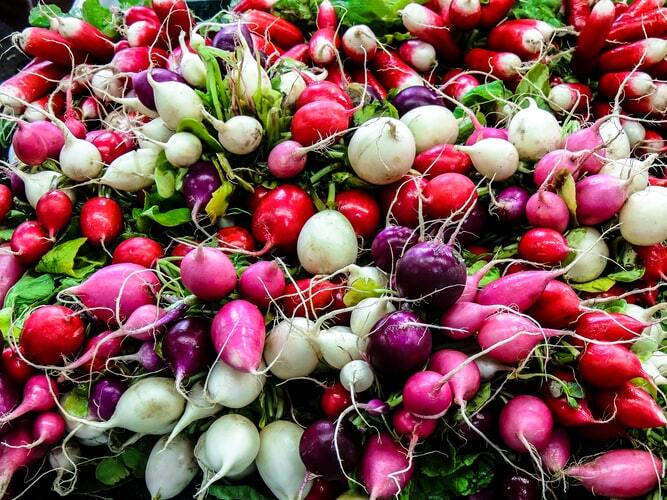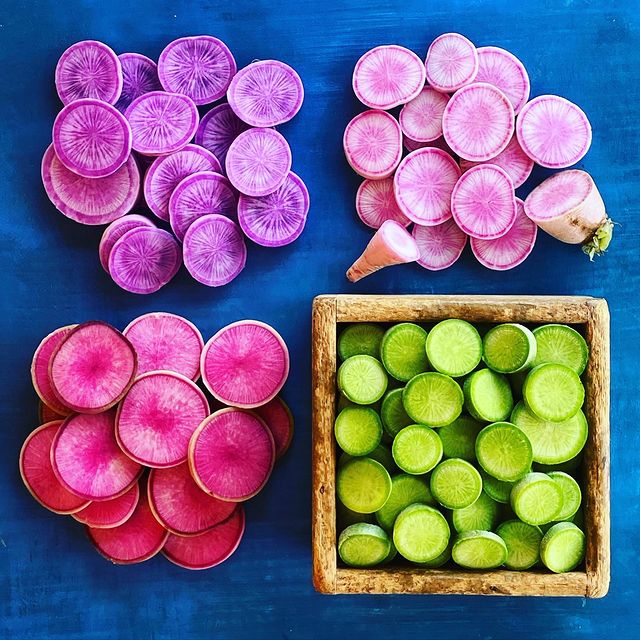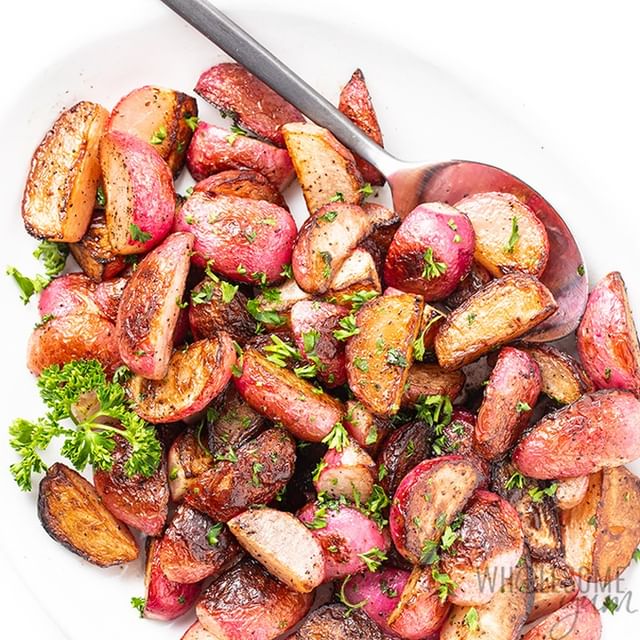
Radishes are adorable with their small size and bright pink-red color. Despite their small size, radishes are loaded with vitamins and minerals. Its peppery flavor makes it ideal for salads, tacos, and more. Learn about the health benefits of radishes and how to prepare them.
What Are Radishes?
The radish is a cruciferous vegetable that thrives in “sunlight and moist, fertile soil,” according to the University of Illinois. According to Vanessa Rissetto, M.S., R.D., C.D.N., co-founder of Culina Health, radishes come in 35 different varieties. According to Michigan State University, the most common are cherry belle — round with red skin and white flesh — and daikon — long and carrot-shaped with white skin and flesh.
Radish Nutrients
“Radishes are a true superfood,” says Megan Byrd, R.D. The high vitamin C, B vitamins and iron content make them a healthy snack. These nutrients are involved in basic physiological processes like red blood cell production and digestion, she says. Radishes, like cauliflower, contain glucosinolates, sulfur-containing compounds with anti-inflammatory and antioxidant properties, according to a Molecules article.
Anthocyanins, or plant pigments, are responsible for the red radish’s color. Anthocyanins, found in plants like berries and purple corn, are powerful antioxidants and anti-inflammatory agents, adding to the long list of radish health advantages. According to the USDA, one cup of raw radishes contains the following nutrients:
- 18 calories
- <1 gram fat
- <1 gram protein
- 4 grams carbohydrates
- 2 grams sugar
- 2 grams fiber

RADISHES ARE HEALTHY
Radishes are loaded with nutrients in each orb. See below for all the radish health benefits according to dietitians and research.
Boosts Immunity
Radishes’ vitamin C and B vitamins help boost the immune system by increasing white blood cell production, says Byrd. “They also help your white blood cells do their jobs,” such as destroying germs and producing antibodies. According to a 2019 review, B vitamins also aid enzymes in the production of organic molecules. This aids in the production of new immune cells.
Lowers Cancer Risk
Radishes contain vitamin C, which may help prevent cancer. Vitamin C is an antioxidant and “a powerhouse in the body’s fight against free radicals,” says Rissetto. (Reminder: free radicals are harmful molecules that can damage cells and contribute to diseases like cancer.)
The National Cancer Institute says that eating radish breaks down glucosinolates into isothiocyanates, which inhibit the growth of cancer in rats and mice. In fact, sulforaphane, an isothiocyanate found in radish seeds, was linked to the death of breast cancer cells in 2017 and lung cancer cells in 2016. (Sulforaphane is also in broccoli sprouts.)
Promotes Digestion
Veggies are high in fiber, which helps keep your digestive system moving. Radishes, with 2 grams of fiber per cup, are a good source of fiber.
“Radishes are high in lignin, an insoluble fiber,” Rissetto says. Insoluble fiber absorbs fluids, wastes, and byproducts produced by the natural digestive process. In turn, this “keeps waste moving in a steady pattern through the GI tract,” preventing constipation and other GI issues.
While radishes have some benefits for gut health, cruciferous vegetables, including radishes, can cause gas, bloating, and abdominal discomfort due to raffinose, a complex sugar that some people struggle to digest.
Reduces Diabetes Risk
Radishes have “antidiabetic effects,” according to a 2017 scientific review. A 2018 review found that radishes’ fiber can slow glucose absorption, preventing blood sugar spikes. Radishes also appear to reduce glucose absorption in the intestines, which may help manage and possibly prevent diabetes.

Radishes: How to Pick, Prepare, and Eat
Radishes are usually sold fresh in the produce section, either with the leaves attached or de-stemmed and bagged. Choose plump, firm, and smooth radishes. Make sure the leaves are vibrant green. Raw radishes taste best when they’re young and about 1-inch wide, according to Texas A & M University.
Rissetto says pickled radishes are occasionally sold frozen or canned. Pickled radishes often contain sugar, so check the ingredients or pickle them yourself, she advises.
MSU advises washing and scrubbing fresh radishes before cutting the root tips and stems to extend their shelf life. Lettuce is a great way to use up leftover stems. While radishes can be peeled, some varieties, like red radishes, benefit from the skin’s peppery flavor. The radishes can then be sliced, diced, grate, or served whole.
Don’t toss those stems and leaves; they’re completely edible. In fact, radish leaves may contain more antioxidants than the vegetable itself. Byrd adds that radish leaves are high in fiber and have a peppery flavor. The stems near the leaves are usually tenderer, while the stems near the radish may be too tough to eat, so compost them.
Refrigerate radishes and their leaves separately. Radishes should last two weeks and leave two to three days, MSU says. Radishes and leaves can be sautéed, roasted, steamed, or eaten raw.
You can start with these tasty radishes recipes at home:
Served roasted – If you don’t like the spicy flavor of raw radishes, try roasting them for 15 minutes at 425°F to bring out their natural sweetness, says Rissetto. Like these maple-roasted radishes with dill feta.
Salad – Add radishes to a boring salad. Make a radish caesar salad with figs, blue cheese, and walnuts for a fun spring salad. Sautéed or roasted radishes go well in warm salads.
As a pickle – For a touch of brightness and acidity, Rissetto adds pickled radishes to meat-based meals. Her DIY recipe calls for radishes, vinegar, sugar, and spices. Let the radishes soak up the flavors for a few minutes (or hours, if you have time). Short on time? Get it at instacart.com for $6.
Garnish – A single peppery radish can go a long way. A thinly sliced radish adds color, nutrients, and flavor to a main dish like this herb-baked salmon. You can also grate or shred radish on avocado toast.

